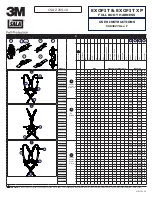
1. The Hazards – Fire & Explosion
Further information
https://www.hse.gov.uk/pubns/indg459.htm
Oxygen enrichment
is the term often used to describe a situation where the oxygen
level is greater than in the air we breathe (approximately 21%
Oxygen). This may vary slightly depending upon local conditions
i.e. the number of people within a given space or where oxygen is
being displaced by normal day to day events.
When enrichment occurs, even a small increase in the oxygen
level to just 24% can create a dangerous situation where:
•
It becomes easier to start a fire, which will then burn hotter and
more fiercely than in normal air.
•
It may be almost impossible to put the fire out
The main danger to people from an oxygen enriched atmosphere
if ignited is that hair or clothing can easily catch fire causing
serious or even fatal burns while receiving oxygen treatment.
2. Oxygen Enrichment Alarm – Action
Action where oxygen enrichment is suspected or indicated:
•
The instrument alarm will sound with the red LED illuminating
•
Where possible turn off the oxygen supply
•
Remove any potential ignition points
•
Make sure the room is well ventilated
•
Find the source of any leak and remedy
•
It is possible that oxygen may contaminate clothing or bedding
within the area. If you suspect contamination remove items
outside for airing
3. Siting the Equipment
Siting of the equipment should be chosen with regards to the
following points.
•
Away from sources of heat with room for adequate air
circulation
•
Convenient to a 230v mains socket outlet
•
Within easy access and audible distance of local staff
•
Within the target area at 1 to 1.5m height
4. Operation
The instrument may be a permanent fixture or be used as a
transportable device and will automatically power up and operate
when connected to a 230v mains supply.
When first powered up the sensor cell will require 2 to 3 minutes
to stabilize and achieve the correct ambient oxygen reading.
The instrument is designed for continuous operation and should
only be switched off when permanently no longer required or is
undergoing routine service.
5. Key Information
•
Normal ambient Oxygen level 20.8 to 21%
•
Instrument alarm set point 23% oxygen
•
Critical Oxygen Enrichment level 24%
•
Alarm status – continuous sounder and red LED indicator.
Note: the instrument sounder and LED cannot be reset beyond
the trip point
•
Full scale reading for the instrument is 25% Oxygen
6. Technical and Maintenance
For instrument technical details see page 2.
The sensor cell mounted in the base of the instrument will
require replacement at 18–month intervals, contact your
equipment supplier for details.
ENVIRONMENTAL DATA






















